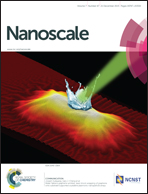An unexpected large capacity of ultrafine manganese oxide as a sodium-ion battery anode†
Abstract
MnO2 is shown for the first time to be electrochemically active as a conversion anode for Na-ion batteries (NIBs). Space-confined ultrafine (UF)-MnO2, with an average crystal size of 4 nm, synthesized using a porous silicon dioxide templated hydrothermal process exhibits a high reversible sodiation capacity of 567 mA h g−1, in contrast to the negligible activity shown by the aggregates of larger (14 nm) MnO2 nanocrystallites. The remarkably enhanced sodiation activity of the UF-MnO2 is attributable to its greatly reduced crystal size, which facilitates diffusion of Na ions, along with high surface energy arising from extensive heterogeneous interfacial bonding with the SiO2 surrounding. The UF-MnO2 anode exhibits an exceptional rate and cycle performance, exhibiting >70% capacity retention after 500 cycles. In operando synchrotron X-ray absorption near-edge structural analysis reveals combined charge-storage mechanisms involving conversion reaction between Mn(III) and Mn(II) oxides, Mn(III)–O1.5 + Na+ + e−- ↔ 1/2Na2O + Mn(II)–O, and non-Mn-centered redox reactions. The finding suggests a new strategy for “activating” the potential electrochemical electrode materials that appear inactive in the bulk form.



 Please wait while we load your content...
Please wait while we load your content...